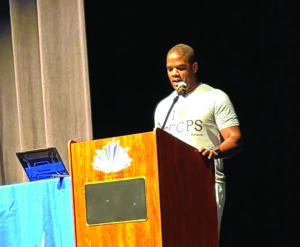The regional economy will slowly begin to recover later this year, and signs of a turn-around will become unmistakable by Labor Day 2010.
But there remain storm clouds further out that could reverse the D.C. region’s current relative strength as compared to the rest of the nation.
Northern Virginia’s foremost economic forecasting guru made these calls to a joint meeting of the Falls Church Chamber of Commerce and Merrifield Business Association at the Italian Café in Falls Church Tuesday.
Dr. Stephen Fuller, the bespectacled, oft-quoted, unflappable head of the Center for Regional Analysis of George Mason University’s School of Public Policy, drew a standing-room-only crowd of business men and women eager for some good news in the face of the current, crushing recession.
They got a lot of reassurance from Fuller that, in his view, the economy is not going off a cliff, and that the federal stimulus efforts are easing the pain while offering, at least for the immediate period, some special benefits to the Northern Virginia regional economy.
Fuller noted that his insights have been in great demand recently, with Tuesday noon’s talk being the fourth he’d given this week so far. He said he had still more on his schedule for that day.
Fuller avoided the doomsday assessments of the current global meltdown, and insisted that it has fallen within the parameters of the seven recession cycles since World War II. While acknowledging the federal stimulus programs have, and will help, allay a steeper decline this time, he indicated nothing special has been underlying the current situation. “We aren’t going to crash. That’s my view,” he said.
However, while insisting he remains an optimist, Fuller did not conclude his comments before identifying a “vulnerability” in the D.C. regional economy that could put it at risk in 2013 or 2014.
The cause, he said, is precisely the region’s appetite for absorbing federal procurement dollars, the same factor that has kept the area’s economy considerably stronger through the current crisis.
It may come, he said, as the federal government will necessarily contract in an effort to cope with the current cost of stimulating a recovery. “There is a risk of slower spending by the federal government,” he said. “That remains a question mark.”
He said that by virtue of its dependence on the federal government, the region could begin to suffer, even disproportionately compared to the national economy by then, if the private sector does not begin to take up the inevitable slack in the meantime.
He also identified the problem that debt obligations from the stimulus efforts will not be met by continuing the current level of tax cuts, and that having to raise taxes in four years or so will slow the national economy again.
“We will continue to grow, but at a slower rate than we’ve been used to, and that could continue for a long time,” he said.
Fuller said that signs of a recovery from the current crisis include a reduction in new unemployment filings, a rise in the rate of new housing starts, a rise in new home sales, and an improvement in consumer expectations about the future.
“Already,” he said, “there are indicators that the public believes the future will be better than the present. The survey data is showing slight improvements in February and March. This is critical for encouraging consumer spending as the cornerstone of a recovery.”
He noted the current stimulus effort, by putting small sums of new money in the public’s pockets through reductions in withholding taxes, is designed to encourage new consumer spending. A key will be in the housing market, he said: “Housing got us into this mess, and it will get us out.”
Housing prices in Northern Virginia rose higher than anywhere in the U.S., and have dropped more, as well, with average prices dipping from $468,700 in 2007 to $394,700 in 2008. The problem was far worse in the outer suburbs, diving by 34.7 percent in Prince William County, 24.7 percent in Loudoun and 17.7 percent in Fairfax. In Prince William, 8 percent of all homes are now in foreclosure.
Fuller predicted the Northern Virginia gross domestic product (GDP) would rise to 4.5 percent in 2010 and reach 5 percent by 2012, but will drop back to 4.5 percent in 2013. Only when GDP tops 3 percent do unemployment numbers begin to drop. While the region’s unemployment level of 6.1 percent (including 9.9 percent in D.C.) is below the current national average of 8.9 percent, it should begin to turn around by the middle of next year, he said.













